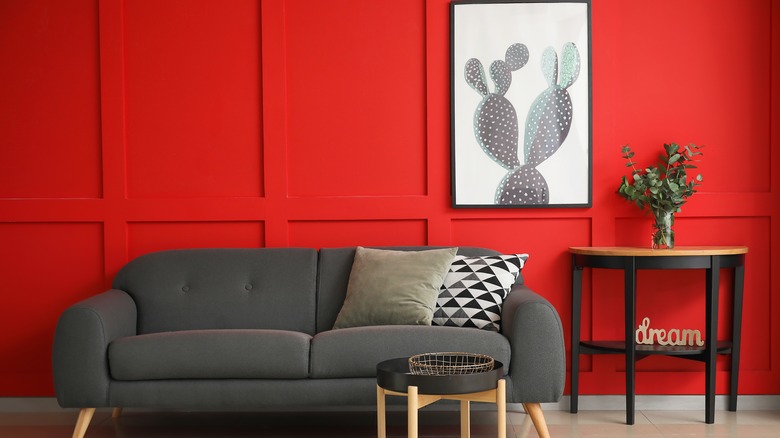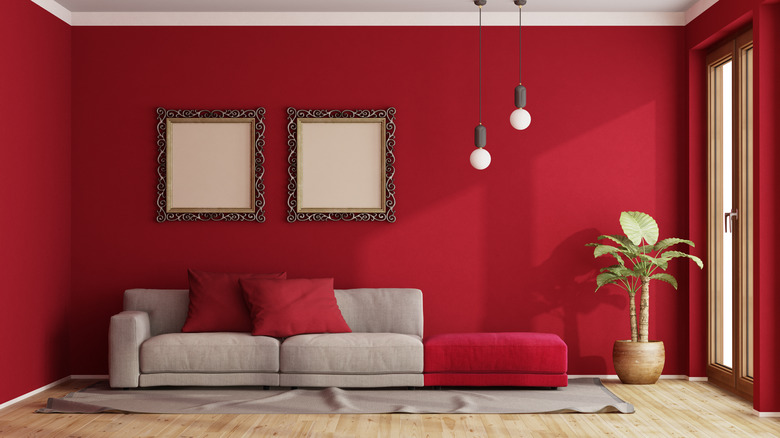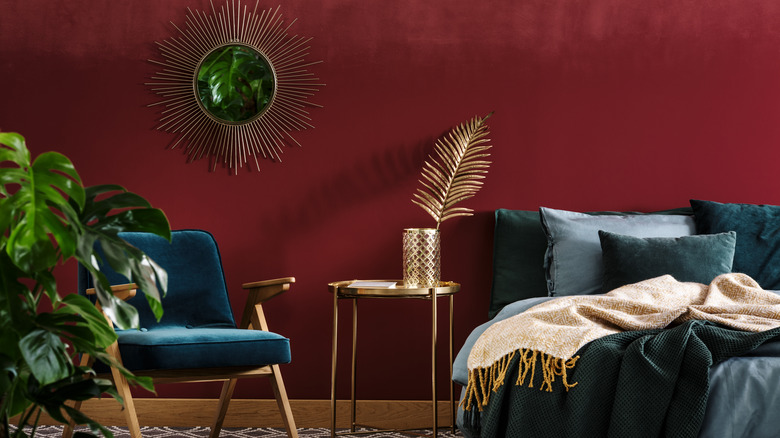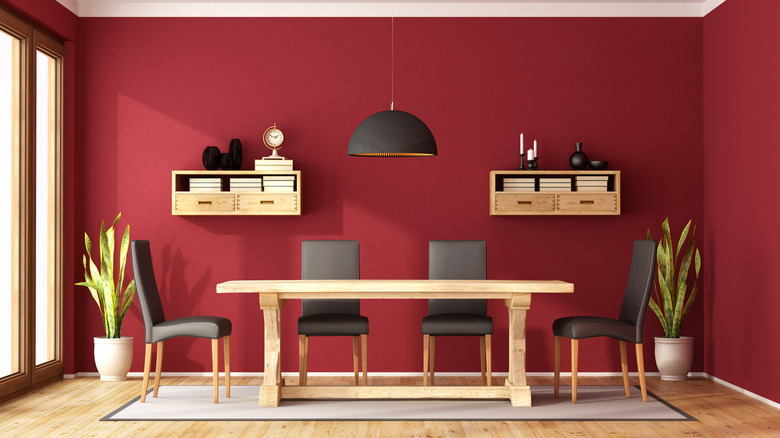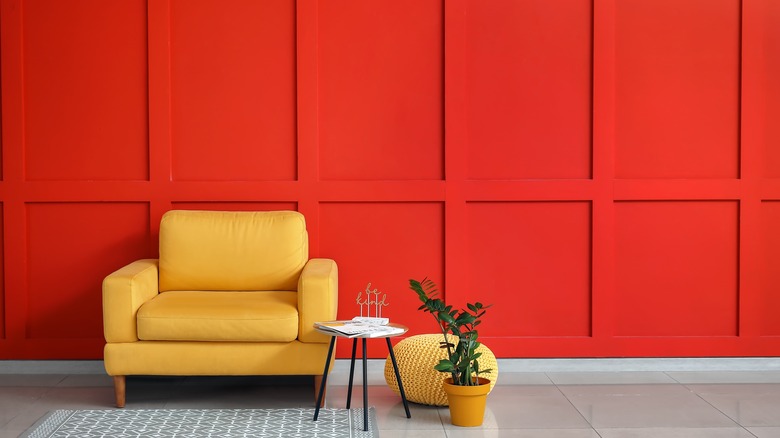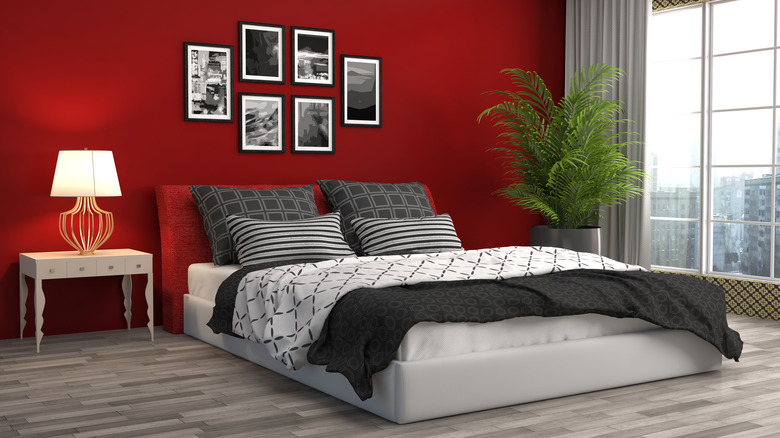An Expert Tells Us 5 Things To Consider Before Painting Your Walls Red
A fresh coat of paint can go a long way in transforming a room. You may be planning to refresh your room or give a space a whole new look, but deciding to paint is only half the battle; now you must decide on the shade you're going to paint the walls. Many people opt for neutral walls because they will easily pair with furniture and decor. But neutral walls can be a bit gloomy and boring, says Genesis Pro Painting and Restoration, especially if you consider your style to be bolder.
For anyone who wants to make a statement, one paint color worthy of consideration is red. Red is vibrant, eye-catching, and passionate, making it the ideal shade for anyone who wants to stand out. But choosing the right type of red for your walls can be difficult. "It should be a reflection of your personal style and taste," Jan Walter, a professional painter with more than 25 years of experience, says in an exclusive interview with House Digest. Jan also runs a blog, Go Colorize, that helps people with all of their home painting DIYs.
As Walter explains, "The most important thing is that you feel comfortable and relaxed in your own home and the color red can be both calming and exhilarating depending on the shade and intensity you choose."
Consider the intensity
The shade of red you choose can make all the difference in your home. Some are deep, matching more with calming earth tones. Others are bright and more pigmented. And some are more muted and soft, similar to pink. Because of the variety in shades, you should test out a few different options. "You can paint a few different shades of red on a wall you plan to paint and see how they look and make you feel before you commit to painting an entire room," suggests Walter. Be sure to paint large swaths rather than smaller squares to get an accurate feel for how the color may look on the walls.
The intensity of the shade may also determine which walls or how many you paint in the room. "Since red is such an intense color you might want to consider only painting an accent wall," says Walter. "Have in mind that if you paint the accent wall near a window that gets a lot of sunlight, the color will radiate through the entire room — and that can be both good and bad depending on what you are going for."
Factor in the size of the room
The same shade of red can vary in appearance in two different rooms. One of those reasons is due to a room's size. "The size of a room can have a big impact on the way it feels," says Walter. "For example, a small bedroom might feel smaller with a dark red, while a large living room might feel cozier." Many experts recommend choosing lighter colors for smaller rooms to help them feel more open and airy, and that goes for vibrant colors as well. "Keep in mind, the darker the color, the more it will close in a space," explains Walter.
There are some trends where highlighting smaller spaces, like powder rooms, with darker colors has become popular. Darker, moodier shades of red might be perfect for this. But if you want to avoid a room feeling closed in or cave-like, opt for a brighter, more vibrant shade, especially if the room has little or no natural light.
Size up the amount of natural light
Ample natural light is highly sought-after by many homeowners. It can illuminate and highlight the space, helping it feel more light and airy. But it can also affect what the design details in a room look like. "The amount of natural light in a room also plays a role in how the color red will look," Walter says. "If a room doesn't have much natural light, a brighter shade of red can make it feel more open and airy." This can be a great option for smaller rooms, basements, or rooms without a lot of windows.
But if you like vivid colors, you may want to opt for rooms with lots of windows. "Natural sunlight is the best light to show off vibrant colors like red," says Walter. Sunlight helps show the full range of the color, so lots of light is preferable. But if that's not the case, don't worry. Walter suggests that "if your room doesn't get a lot of sun, you might want to consider a lighter shade."
Consider whether there is already a lot of red in the room
Interior design is all about balancing all of the features and details in a space. Balancing colors is essential because too much of one color can quickly become overwhelming. "Reds are powerful, passionate colors," says Walter. "They can evoke feelings of love, anger, or excitement. When used in the design, red can create a bold statement or add a touch of warmth to a space." These visceral feelings are what often draw people to the color red — but it also means taking some precautions.
"However, it is important to consider the existing color scheme before adding red to a room," warns Walter. "If the space already features a lot of red, then adding more of the same color may create an overwhelming effect. Again, it might be better to use red as an accent color to provide contrast and visual interest." If you paint all of your walls red, it might be best to choose less vibrant furniture and decor, or at least details that aren't also red. But if you have a red sofa or lots of red decor, a single red accent wall on the opposite side of the room might be a better way to balance the design.
Decide on the type of gloss you want to use
Choosing the right shade of paint isn't the only decision you have to make — you also have to consider the finish of the paint. "The type of gloss you select will also play a role in the overall look of the room," states Walter. "For example, matte/flat paint will give a more muted look and will hide imperfections in the walls, while semi-gloss or high-gloss paint will reflect light and will show off any imperfections." The gloss of the paint can also help communicate your interior style. Matte paints can feel more modern, while glossy paints feel more traditional.
You should also think about your lifestyle when choosing a paint finish. Walter says, "Keep in mind that glossy surfaces are also easier to clean, so they may be a good choice for rooms that see a lot of traffic." Easy-to-clean paint is also great for families with young children who may have to clean food or crayon off the wall. Glossy paints wipe down much easier than those with a matte finish.
